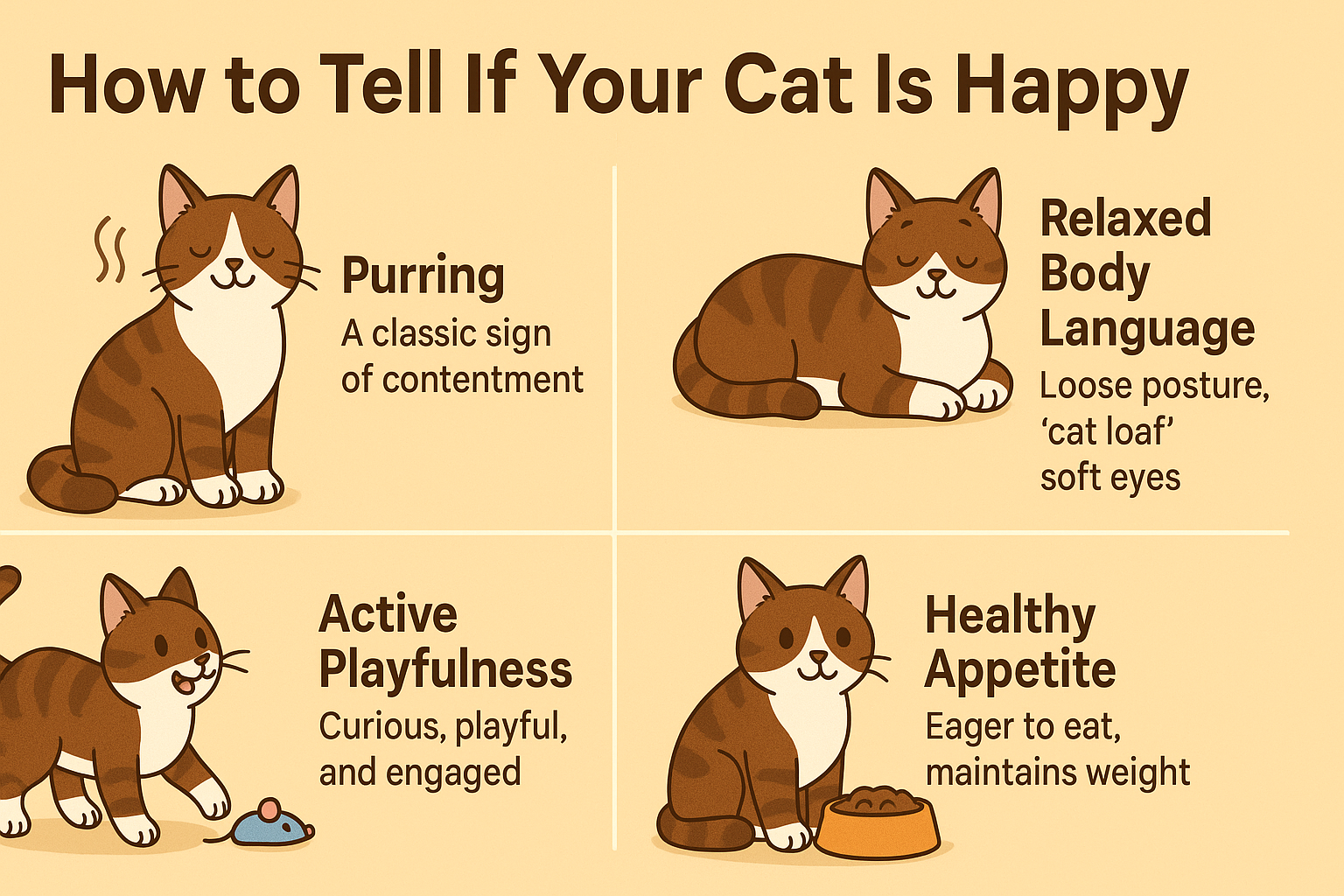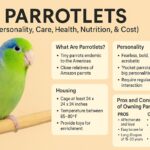Cats are known for their mysterious personalities and subtle ways of communicating. Unlike dogs, who often wear their emotions on their sleeves, cats tend to keep their feelings more guarded.
This can leave many cat owners wondering: Is my cat truly happy? While every cat is unique, there are clear signs that indicate your feline friend is content and living a good life. Understanding these signals not only helps you ensure your cat’s well-being but also strengthens the bond you share.
In this comprehensive guide, we’ll explore the top 10 signs of a happy cat, explain what each behavior means, and offer practical tips for keeping your kitty content. All factual information is drawn from trusted veterinary sources and pet care experts.

1. Purring: The Classic Sign of Contentment
Purring is perhaps the most universally recognized sign of a happy cat. When your cat curls up beside you and starts to purr, it’s usually a sign of comfort and satisfaction. The gentle, rhythmic sound is often heard when a cat is being petted, snuggling, or simply relaxing in a safe environment.
However, it’s important to remember that purring can also occur when a cat is anxious, in pain, or even hungry. Context matters. If your cat is purring while displaying other signs of happiness-such as a relaxed posture, soft eyes, and slow blinking-you can be confident that your cat is feeling good.
2. Relaxed Body Language
A happy cat’s body language is relaxed and open. Look for these physical cues:
- Soft, smooth fur: The coat appears well-groomed and healthy, indicating your cat feels good and is taking care of itself.
- Loose, relaxed posture: A content cat may sprawl out on its side or back, exposing the belly (though this isn’t always an invitation for a belly rub).
- Tucked paws (“loaf” position): When a cat tucks its paws under its body and looks like a loaf of bread, it’s a sign of comfort and trust in its environment.
- Ears and eyes: Ears are upright or gently forward, and eyes are soft, sometimes with slow blinking. This indicates relaxation and happiness.
3. Active Playfulness and Curiosity
Play is a strong indicator of a happy cat. Cats are natural hunters, and even indoor cats express this instinct through play. A content cat will:
- Chase toys, pounce, and engage in “hunting” behaviors around the house.
- Explore new objects and environments with curiosity.
- Initiate play with you or other pets.
If your cat is regularly active, playful, and curious about its surroundings, it’s a good sign that they’re mentally stimulated and emotionally satisfied.
4. Healthy Appetite and Eating Habits
A happy cat typically has a healthy appetite and enjoys mealtimes. While appetite alone doesn’t guarantee happiness, sudden changes in eating habits can signal stress or illness. Key things to watch for:
- Eagerly comes to eat at mealtimes.
- Maintains a healthy weight.
- Shows excitement for favorite treats or foods.
If your cat is eating well and maintaining a healthy weight, it’s a sign that they feel safe and secure in their environment.
5. Kneading (“Making Biscuits”)
Kneading is the rhythmic pressing of paws against a soft surface, like a blanket or your lap. This behavior originates from kittenhood, when kittens knead their mother’s belly to stimulate milk flow. Adult cats knead when they feel safe, secure, and content.
If your cat kneads while purring or snuggling with you, it’s a strong sign of happiness and trust. Some cats even drool a little while kneading, which is another indicator of deep contentment.
6. Socializing and Seeking Affection
Happy cats often seek out interaction with their humans or other pets. Signs of social contentment include:
- Rubbing their face or body against you (marking you with their scent).
- Head-butting, nuzzling, or gently bumping you with their head.
- Sitting on your lap, sleeping near you, or following you from room to room.
- “Talking” to you with soft, high-pitched meows or chirps.
A cat that actively seeks your company and enjoys being petted or snuggled is showing clear signs of happiness.
7. Regular Grooming and a Healthy Appearance
Cats are meticulous groomers, and a happy cat will keep its coat clean and shiny. Regular grooming indicates that your cat feels well and is not stressed or ill. Additional signs include:
- Grooming other cats or even you, which shows trust and affection.
- A healthy, glossy coat with no bald patches or excessive shedding.
If your cat suddenly stops grooming or appears unkempt, it could be a sign of stress or health problems and should be checked by a veterinarian.
8. Calm and Relaxed Posture
A content cat often lounges in a relaxed position, with its body stretched out or curled up comfortably. Other signs of calmness include:
- Sleeping with paws tucked under the body (the “cat loaf”).
- Lying on their side or back, sometimes exposing the belly.
- Slow, deliberate movements rather than tense or jittery actions.
Cats that feel safe and happy will often sleep in open, exposed areas rather than hiding away.
9. Tail Language: The High Tail and Gentle Curves
A cat’s tail is a powerful indicator of mood. A happy cat will often carry its tail upright, sometimes with a gentle curve at the tip. This “question mark” tail is a friendly greeting and shows your cat is comfortable in its environment.
Other positive tail signals include:
- A softly swishing tail when relaxed.
- Wrapping the tail around their body or your arm as a sign of affection.
Conversely, a low or puffed-up tail can indicate fear or agitation, so a high, gently curved tail is a welcome sign of happiness.
10. Interacting with the Environment
Happy cats are engaged with their surroundings. This can include:
- Scratching posts or furniture (a natural behavior to mark territory and stretch muscles).
- Watching birds or squirrels from the window, sometimes chirping or chattering in excitement.
- Exploring new areas of the house or investigating new objects with interest.
These behaviors show that your cat feels safe enough to express natural instincts and explore their world.
The Importance of Context: Understanding Your Cat’s Unique Personality
While the ten signs above are reliable indicators of happiness in most cats, it’s important to remember that every cat is an individual. Breed, age, history, and personality all play a role in how your cat expresses contentment. For example, some cats are naturally more vocal or playful, while others are quiet and reserved. A shy or senior cat might not seek out as much physical affection but can still be perfectly happy in your presence.
Pay Attention to Your Cat’s Baseline Behavior
The best way to tell if your cat is happy is to get to know their normal behavior. If your cat usually greets you at the door, plays with toys, and enjoys being petted, a sudden withdrawal or change in these habits could signal a problem.
On the other hand, a cat who has always been independent and aloof may show happiness in subtler ways, such as sitting nearby or blinking slowly at you.
When to Worry: Signs Your Cat May Not Be Happy
Recognizing happiness is important, but so is knowing when something is wrong. Cats are experts at hiding pain and stress, so changes in their usual behavior should not be ignored. Here are some warning signs that your cat may be unhappy, stressed, or unwell:
- Hiding more than usual: While cats love cozy spots, excessive hiding can indicate fear, anxiety, or illness.
- Loss of appetite or overeating: Sudden changes in eating habits are often a red flag.
- Aggression or sudden mood changes: Hissing, biting, or swatting without clear reason can signal discomfort.
- Overgrooming or lack of grooming: Both can be signs of stress or health issues.
- Lethargy or lack of interest in play: A normally playful cat who becomes withdrawn may be unwell.
- Changes in litter box habits: Urinating or defecating outside the box can indicate stress, medical issues, or dissatisfaction with the litter box setup.
If you notice any of these signs, it’s important to consult your veterinarian to rule out medical problems and address any emotional or environmental stressors.
Tips for Keeping Your Cat Happy
Now that you know how to recognize happiness in your cat, let’s look at some practical ways to keep your feline friend content and thriving.
1. Provide a Safe and Enriched Environment
Cats need a secure, stimulating environment to feel happy. This includes:
- Safe hiding places: Boxes, cat trees, or cozy beds where your cat can retreat when they need privacy.
- Vertical space: Cats love to climb and observe their territory from above. Cat trees, shelves, or window perches are great additions.
- Scratching posts: Essential for claw health and marking territory.
- Variety of toys: Rotate toys to keep playtime interesting and encourage exercise.
2. Maintain a Consistent Routine
Cats are creatures of habit and feel most secure when their daily routine is predictable. Try to feed, play, and interact with your cat at roughly the same times each day. Sudden changes in routine can cause stress.
3. Encourage Play and Mental Stimulation
Interactive play is vital for your cat’s mental and physical health. Use wand toys, laser pointers, or puzzle feeders to engage your cat’s hunting instincts. Even a few minutes of play each day can make a big difference.
4. Offer Social Interaction on Their Terms
While some cats are lap lovers, others prefer less physical contact. Let your cat decide when and how they want to interact. Respect their boundaries and never force affection.
5. Keep the Litter Box Clean and Accessible
A clean, well-placed litter box is essential for your cat’s comfort. Scoop daily, change litter regularly, and provide one box per cat (plus one extra if you have multiple cats).
6. Provide High-Quality Nutrition
Feed your cat a balanced diet appropriate for their age, health, and activity level. Clean, fresh water should always be available.
7. Regular Veterinary Care
Routine checkups help catch health problems early and keep your cat feeling their best. Vaccinations, dental care, and parasite prevention are all important.
8. Offer Opportunities for Safe Outdoor Exploration
If possible, provide a safe outdoor space like a catio or use a harness and leash for supervised outdoor adventures. Watching birds, smelling fresh air, and exploring new sights can enrich your cat’s life.
9. Respect Their Need for Rest
Cats sleep an average of 12-16 hours a day. Make sure your cat has quiet, comfortable places to nap undisturbed.
10. Show Love and Patience
Every cat is different. The most important thing you can do is pay attention, be patient, and show your cat love in the ways they appreciate most.
Frequently Asked Questions About Cat Happiness
How can I tell the difference between a happy cat and a stressed cat?
Happy cats display relaxed body language, a healthy appetite, and engage in play or social interaction. Their eyes are soft, their posture is loose, and they often purr or knead when content. Stressed or unhappy cats may hide, become aggressive, overgroom or stop grooming, and show changes in eating or litter box habits. Always look at the whole picture and consider your cat’s typical behavior.
Is it normal for my cat to not want to cuddle?
Absolutely. Not all cats are lap cats. Some prefer to show affection by sitting nearby, following you from room to room, or giving you slow blinks. Respect your cat’s preferences and offer affection in the ways they enjoy most. As long as your cat seeks your company in their own way, they are likely happy.
My cat sleeps a lot. Is that a sign of unhappiness?
Cats are naturally big sleepers, averaging 12 to 16 hours a day. As long as your cat is playful and engaged when awake, has a healthy appetite, and shows other signs of contentment, a lot of sleep is normal. If your cat becomes lethargic or loses interest in things they once enjoyed, consult your vet.
Can an indoor cat be as happy as an outdoor cat?
Yes, indoor cats can be just as happy as outdoor cats, often with fewer health risks. The key is providing plenty of enrichment, play, safe spaces, and stimulation. Window perches, interactive toys, and even safe outdoor enclosures (catios) can help indoor cats enjoy the best of both worlds.
Should I get another cat to keep my cat company?
Some cats thrive with a feline companion, while others prefer to be the only pet. Consider your cat’s personality and past experiences with other animals. If you’re thinking about adopting another cat, introduce them slowly and monitor their interactions. Forced companionship can cause stress if not managed carefully.
Conclusion
Cats may be mysterious, but they are always communicating with us through their behavior, body language, and routines. By learning to recognize the clear signs of happiness, you not only ensure your cat’s well-being but also deepen the special bond you share.
Remember, a happy cat is one who feels safe, loved, and stimulated. Provide a secure home, regular play, and plenty of affection on your cat’s terms. Pay attention to changes in behavior, and don’t hesitate to consult your veterinarian if something seems off.
Every cat is unique, and what makes one cat happy might not work for another. The most important thing is to respect your cat’s individuality and do your best to meet their needs. In return, you’ll enjoy the company of a content, loving feline companion who brings joy to your life every day.
References
- American Association of Feline Practitioners: Cat Friendly Homes
- Cornell University College of Veterinary Medicine: Feline Behavior Problems
- American Veterinary Medical Association: Caring for Your Cat
- International Cat Care: Understanding Cat Behavior
- The Humane Society of the United States: How to Keep Your Cat Happy Indoors
- American Association of Feline Practitioners: Environmental Needs Guidelines
- International Cat Care: Keeping Your Cat Happy
- ASPCA: General Cat Care
- 9 Types of Lovebirds (A Comprehensive Guide for Pet Bird Owners) - June 20, 2025
- Labrador Retriever: America’s Most Beloved Family Dog - June 9, 2025
- The Complete Guide to Indian Ringneck Parrots - June 9, 2025














